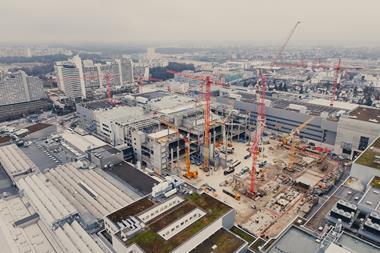OEMs’ workers must help to deliver higher volume and quality in a globalised industry
Demand for improved quality and higher production targets means that the training of workers and the constant refreshment of their skills is a crucial component of any vehicle-maker’s business strategy. It is not just the manufacturing processes that need to be learned, but the overall company philosophy which often drives the processes themselves. A further complication is the growing globalisation of the manufacturing supply chain, which creates a need to ensure consistency in the skill levels of managers and employees around the world.

One solution is to set up a hub for training operations, such as Renault’s Global Training Centre (GTC) in Flins, France. Inspired by the system put in place by Renault’s partner Nissan in 2005, the GTC operates alongside the production school for body assembly plants, at Flins since 2010, and powertrain plants, at Cléon since 2012.
Getting to the heart of training at Renault Flins
Renault’s GTC has three objectives: to support new international projects, to deploy the fundamental practices underpinning company activities and to maintain critical skills. From the company’s new plant in Tangiers, Morocco, to the new B0 line in Togliatti, Russia, several thousand employees have benefited from the GTC. “In this way, the GTC is seeking not solely to maintain positions in Europe, but also to pursue international expansion,” explains Bernard Fraboulet, head of the GTC.
The new facility in Togliatti One provides an example of the role of the GTC. The Renault-Nissan alliance has invested €400 million in the AvtoVAZ plant, which hosts the new B0 production line that has a capacity of 350,000 cars per year. It will produce five separate models across the three companies and keep costs to a minimum.
For such an ambitious facility, training was vital. In 2011, around 100 workshop and unit managers assigned to the new B0 assembly line undertook training at the GTC. “We introduced them to the Renault culture, based on quality and organisation, but they also followed French intercultural models,” says Fraboulet. “Then they were trained to apply the Renault Production Way (RPW).” As the majority of the staff were Russian speakers, the presence of interpreters was essential for achieving good results.
Renault’s manufacturing operations encompass 66,000 employees, 38 production sites and seven logistics sites in 17 countries. Although such cultural diversity can be considered a source of wealth, it is a challenging situation in which to apply the same production fundamentals at all locations and therefore boost performance while cutting costs. However, according to Fraboulet, “the GTC meets this challenge every day, by preparing representative training co-ordinators so that they can cascade training content at their home sites, all over the world.”
The core training programme at the GTC is structured around the fundamentals of the Renault Production Way. Over a period of eight weeks, trainees are placed in a simulated production area with an educational toy vehicle codenamed YK04, similar to Nissan procedure. Using the knowledge acquired during the course, trainees apply the RPW in role play and aim to improve the performance of their production line. “This complete approach to production management is both simple and lively,” Fraboulet continues. “It enables trainees to really understand Renault production methods. The real performance lies in meshing together the various aspects of the approach.”
At the GTC, trainees can learn not only the mainstays of the RPW, but also the fundamentals of press shop activities or maintenance, or the basic principles of standard tasks in the fields of safety or reworking.
In early 2012, in order to increase synergies between Renault and Nissan, the production school sent one of its function advisors on a one-month total immersion course to Nissan’s GTC in Japan. The advisor undertook a basic course in machining as a trainee, with a view to setting up a similar programme for the GTC at Cléon.
Learning the Nissan Production Way
For Nissan’s US operations, all new employees go through four weeks of department-specific basic skills training and on-the-job training which is conducted via a three-step method: explanation, demonstration and participation. Once staff are trained in the manufacturing processes, they use conventional Standard Operation Sheets (SOS) as prompts or on-line guidance. At Nissan these are currently in paper form, but many manufacturers are looking into using tablet devices. Additionally, weekly cross-functional department meetings are held to share and leverage best practices and process improvements.
When it comes to installing new machinery, the complexity of the equipment determines whether training is provided by in-house experts or comes as part of the package from the supplier. The standard method is ‘train the trainer’, where vendors train experienced personnel or Nissan trainers develop other employees. An internal technical training department keeps the skilled trades employees proficient on technology changes that involve PLCs, robots and automated equipment.
The majority of new technologies or processes are proven at a test facility before being rolled out worldwide. “Since Nissan is a global company, key personnel may be sent to Japan or other countries where Nissan has operations for formal training on a new model line,” says Justin Saia, manager at Nissan US. “These employees then come back and train other employees in their department.
“Employees are trained on the Nissan Way, which includes the mindsets and actions for running our business. Nissan Production Way is our method of managing the plant and incorporates the use of Global Genba Kanri (GGK). GGK is our internal method for setting shop standards and auditing ourselves to those standards. This is similar to ISO 9001 standards.”
Demographic implications for training
Workers at both end of the age scale can represent challenges for their employers. At the younger end, the automotive sector is similar to other industries in that it struggles to attract the quality of recruits that it needs. Meanwhile, at the other end of the spectrum, it is often the IT-related disciplines, such as CAD design, which cause most issues among older workers.
The answer to a lack of skills among young workers has been a rebirth of the traditional apprenticeship scheme. For example, at the UK’s Dunton Technical Centre, the Ford Higher Apprenticeship Programme involves apprentices working alongside chartered engineers across key aspects of delivering a full powertrain solution. This provides practical work experience using world-class technologies, while building knowledge of theoretical principles.
“We are delighted to be offering a Higher Apprenticeship Programme at Ford Motor Company,” says Ford of Britain apprenticeship manager, Tessa Hougham. “What is unique about the scheme is the blended approach to learning and working, which enables the direct application and reinforcement of new skills. Every participant will develop and grow their deep technical knowledge and obtain a degree while also performing work-based assignments that add value to our business.”
From a broader perspective, training departments are facing a demographic time bomb. In Europe, this may be an even more serious issue than the current economic crisis. “The ageing of Europe’s population is certainly a challenge,” states Kirstin Donoghue, autodesk partner manager, EU, at KnowledgePoint. “Over the last 50 years, life expectancy at birth has increased by around ten years and projections foresee a further five-year extension over the next half a century. But far from giving us all more leisure time to look forward to, it means working far into our sixties and perhaps beyond. Today’s 30-year-olds may need to work for another 40 years.”
 Workers in their thirties and above may also believe that they have finished their learning and be in danger of complacency. However, technology is changing faster than ever before and even employees who graduated less than a decade ago may now be working in an outdated fashion. Donoghue says that training and certification can prove valuable for workers “who in earlier times may have been approaching retirement”, adding that the EU’s number of workers aged 55-64 is set to increase by 24 million by 2030.
Workers in their thirties and above may also believe that they have finished their learning and be in danger of complacency. However, technology is changing faster than ever before and even employees who graduated less than a decade ago may now be working in an outdated fashion. Donoghue says that training and certification can prove valuable for workers “who in earlier times may have been approaching retirement”, adding that the EU’s number of workers aged 55-64 is set to increase by 24 million by 2030.
Yet many older professionals started their working lives in a completely different environment from today, when globalisation was not so established, jobs were not so scarce and employers were not so risk averse when it came to hiring staff, and were therefore more willing to train on the job rather than insist on certain qualifications.
In changing times, consistency seems to be the message of the day. “An increasingly mobile workforce has created the need for more consistent training and a universal global standard to enable employers – who are not necessarily technically-skilled themselves – to assess whether or not a candidate can do the job,” says Donoghue.
“As a result, professional training leading to certification of design and engineering IT skills is becoming increasingly important. Certification provides a universal standard to ensure consistency and relevance of skills. An engineer in India, for example, has the same qualification as one in Greece, France or the UK. In this way, certification becomes more desirable than national schemes.”


































